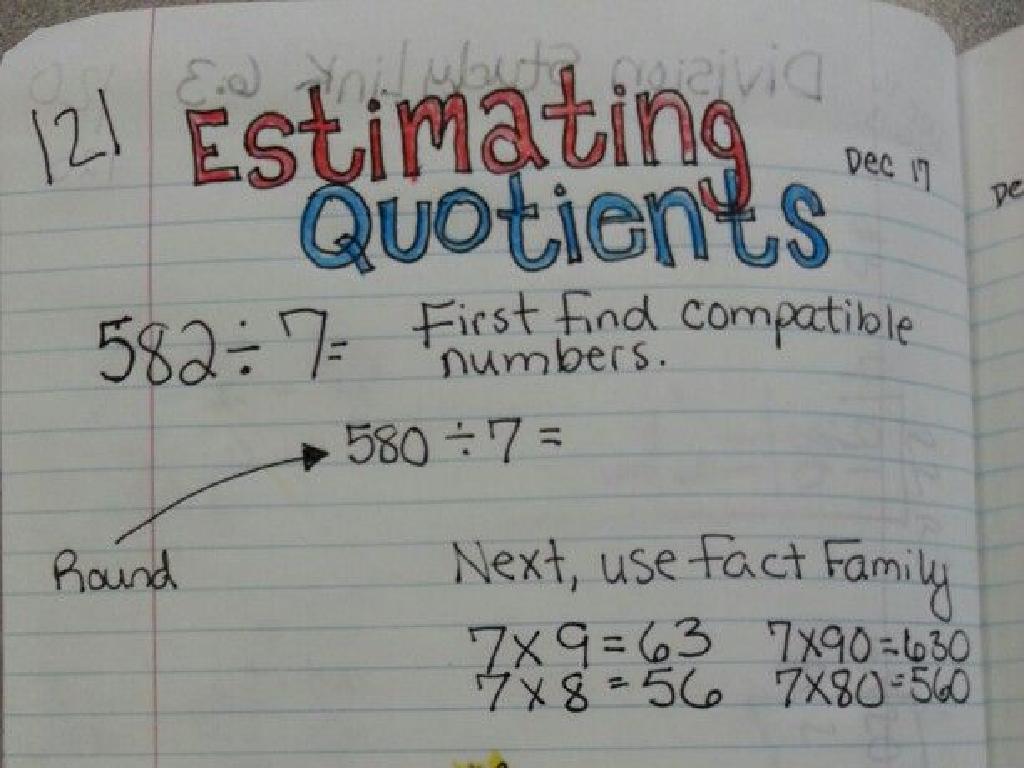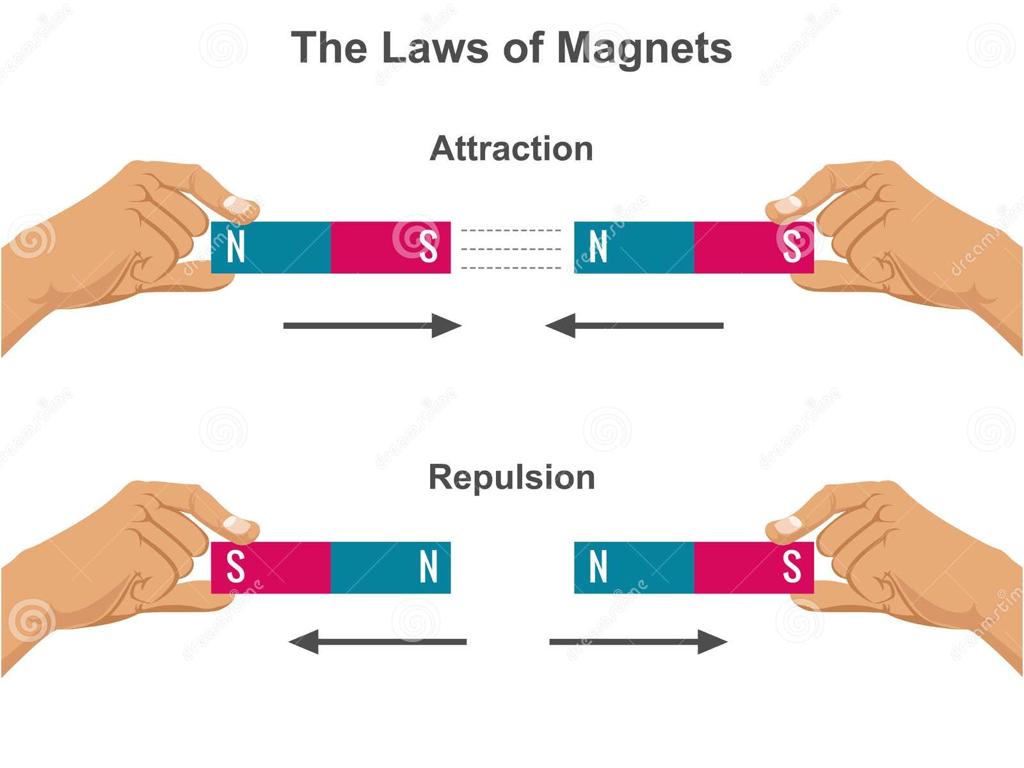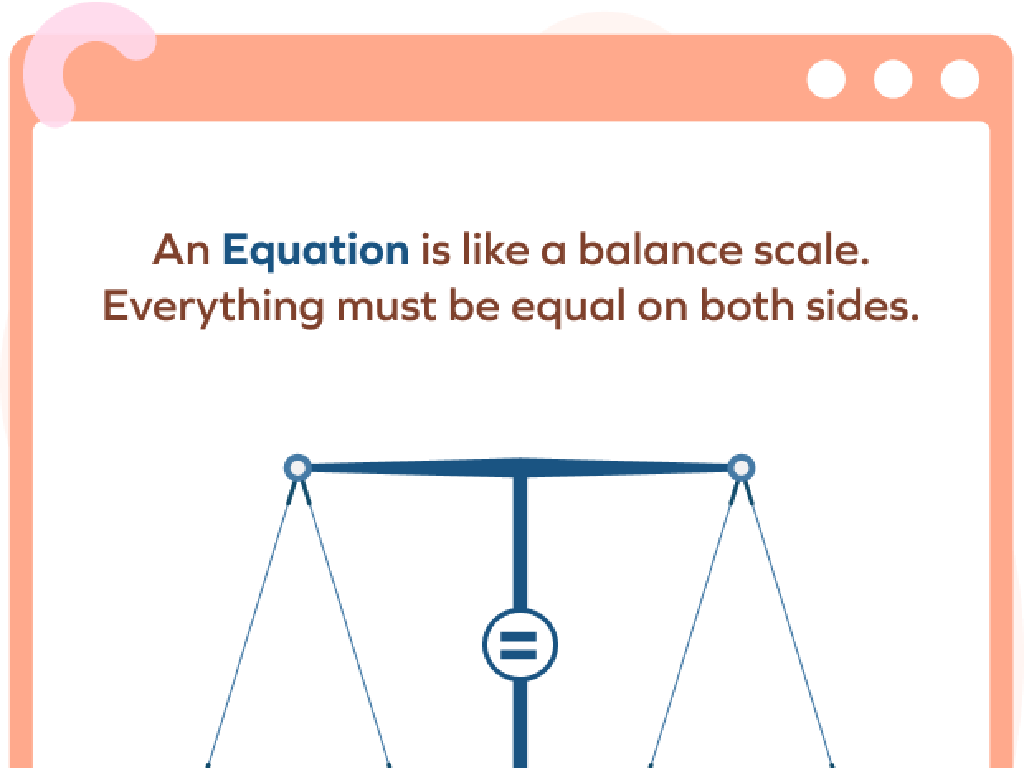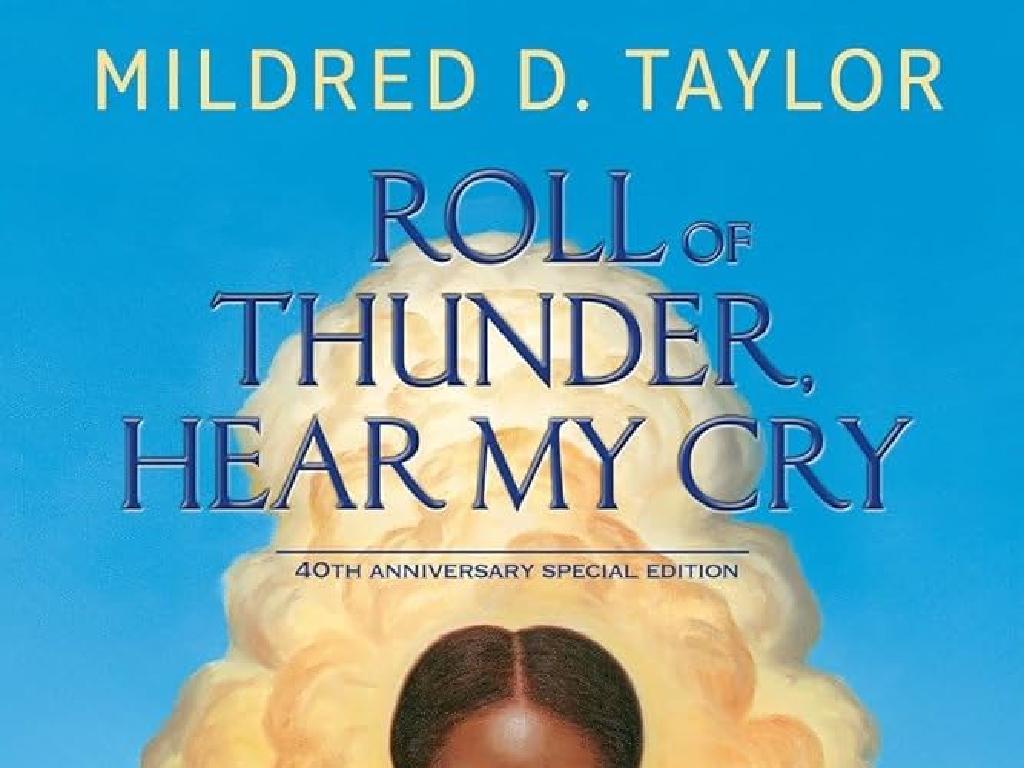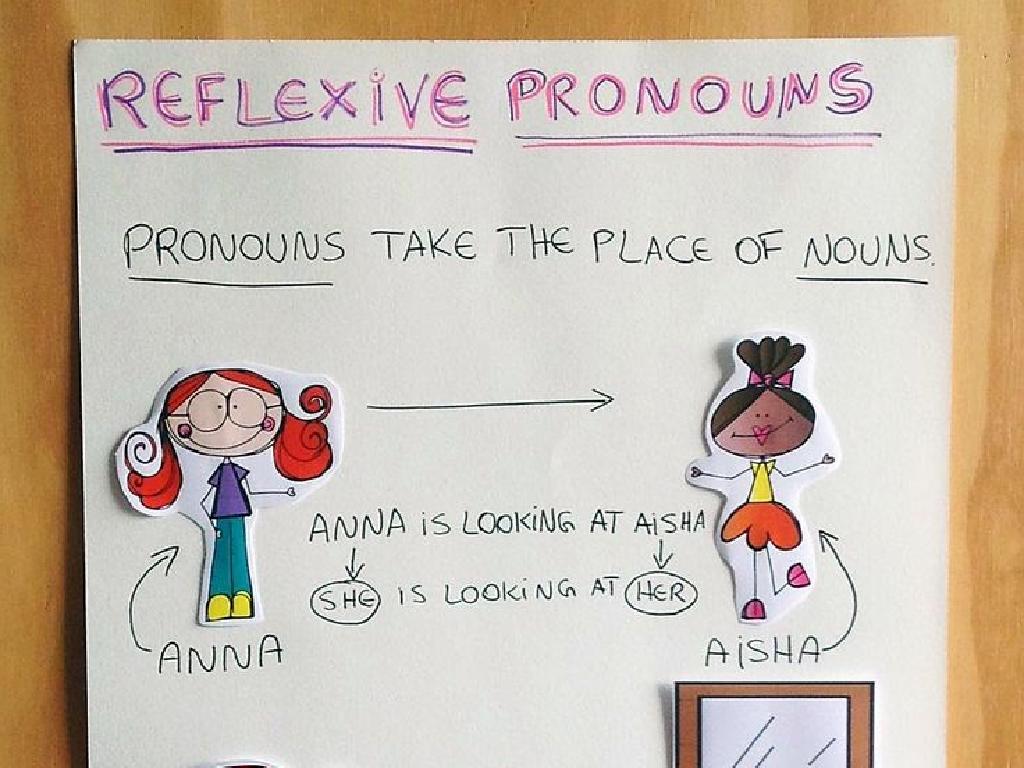Multiply Decimals And Whole Numbers: Word Problems
Subject: Math
Grade: Fifth grade
Topic: Multiply Decimals By Whole Numbers
Please LOG IN to download the presentation. Access is available to registered users only.
View More Content
Today’s Adventure: Decimal Multiplication!
– Real-life multiplication application
– Multiplication is used in shopping, cooking, and more.
– Connect decimals to daily scenarios
– For example, calculating money or measuring ingredients.
– Steps to multiply decimals by whole numbers
– Line up the numbers ignoring the decimal, multiply, then place the decimal in the answer.
– Practice problems for mastery
– Solve problems related to real-life situations to reinforce the concept.
|
This slide introduces students to the practical applications of multiplying decimals by whole numbers, emphasizing the connection to real-life situations such as shopping and cooking. Begin by discussing how multiplication is a part of daily life, then explain the process of multiplying decimals step by step. Ensure to clarify the placement of the decimal point in the product. Provide practice problems that students can relate to, such as calculating the total cost of items or measuring ingredients for a recipe. The goal is for students to understand the concept and become comfortable with decimal multiplication through relevant examples and consistent practice.
Understanding Decimals in Multiplication
– Recap: Decimals and place values
– Decimals represent parts of a whole, like cents in a dollar.
– Decimals vs. Whole Numbers
– Decimals have a ‘point’, whole numbers do not.
– Everyday examples of decimals
– Using money: $0.75, measuring: 1.5 meters, time: 2.5 hours.
– Multiplying decimals with whole numbers
– Example: 4 x 0.5 = 2. It’s just like whole number multiplication, but with a decimal.
|
Begin with a brief review of what decimals are, emphasizing their place value system. Highlight the differences between decimals and whole numbers, particularly the presence of the decimal point and the concept of values less than one. Provide relatable examples such as money, measurements, and time to illustrate decimals in real life. Transition to multiplying decimals by whole numbers by showing that the process is similar to multiplying whole numbers, but with an extra step of placing the decimal in the answer. Encourage students to think of real-world situations where they might need to multiply a decimal by a whole number, like buying multiple items priced with cents.
Multiplying Decimals and Whole Numbers
– Refresh: Multiplying whole numbers
– Review how to multiply numbers like 3 x 4
– Steps of multiplication process
– Learn to multiply step by step, e.g., 23 x 5
– Practice multiplication together
– Apply skills to word problems
– Use examples to solve decimal problems
|
Begin with a quick refresher on multiplying whole numbers to ensure students are comfortable with the basic process. Break down the steps of multiplication, starting with single-digit numbers and progressing to larger numbers. Engage the class by solving a few examples together on the board, encouraging participation. Then, transition to applying these skills to word problems involving decimals, demonstrating how the same principles apply. Provide clear examples, such as multiplying price per item by quantity to find total cost, to illustrate real-world applications. The goal is to build confidence in their multiplication skills before introducing decimals into the mix.
The Magic of Multiplying Decimals by Whole Numbers
– Comparing decimal & whole number multiplication
– Decimals have a ‘dot’ to keep track of, unlike whole numbers.
– Aligning the decimal point
– Place the decimal point in the product correctly.
– Step-by-step multiplication guide
– Multiply as if whole numbers, then place the decimal.
– Practice with word problems
– Apply steps to solve real-world math problems.
|
This slide introduces students to the concept of multiplying decimals by whole numbers. Start by discussing the difference between multiplying whole numbers and decimals, emphasizing the presence of the decimal point. Explain the importance of aligning the decimal point to maintain the value of the number. Provide a clear, step-by-step guide on how to perform the multiplication, treating the decimals as whole numbers initially and then placing the decimal point in the correct position in the answer. Conclude with examples of word problems to apply what they’ve learned, ensuring to include real-world scenarios that make the math concept relevant and engaging for the students.
Let’s Practice Together: Multiplying Decimals
– Example 1: Decimal by one-digit number
– Multiply 0.5 (half dollar) by 3 (friends) to find total money shared.
– Example 2: Decimal by two-digit number
– Multiply 0.75 (three quarters) by 24 (hours) to calculate a day’s earnings.
– Class participation in solving
– Understanding through practice
– Practice solidifies the concept and helps identify common mistakes.
|
This slide is designed to engage the class in active participation while learning to multiply decimals with whole numbers. Start with a simple example, such as multiplying a half dollar (0.5) by a number of friends (3) to find out how much money is shared among them. Then, increase complexity by multiplying three quarters (0.75) by the number of hours in a day (24) to calculate a day’s earnings. Encourage students to work through these examples as a class, fostering a collaborative learning environment. Emphasize the importance of practice in understanding the multiplication of decimals and whole numbers, and use this opportunity to address any misconceptions or common errors. Provide additional examples if time allows and ensure that each student is following along and engaging with the material.
Word Problems: Multiplying Decimals and Whole Numbers
– Understand the problem’s goal
– What is the question asking us to find?
– Identify numbers to multiply
– Find the decimal and the whole number in the problem
– Solve the problem step by step
– Use multiplication methods we’ve learned
– Check your answer for accuracy
– Review your steps and ensure the answer makes sense
|
This slide is aimed at helping students apply their knowledge of multiplying decimals by whole numbers to solve word problems. Start by reading the problem carefully to understand what is being asked. Then, identify the decimal and the whole number that need to be multiplied. Walk the students through solving the problem step by step, using the methods they’ve learned in class. Emphasize the importance of checking their work to ensure the answer is reasonable and accurate. Encourage students to verbalize their thought process as they work through the problem, as this can help solidify their understanding and aid in error checking.
Group Activity: Decimal Multiplication Challenge
– Break into groups for word problems
– Solve decimal multiplication problems
– Use multiplication to combine decimals and whole numbers
– Present solutions and explain methods
– Share your group’s answer and how you got it
– Discuss various solving strategies
– Compare different approaches to find the best one
|
This group activity is designed to foster collaboration and discussion among students as they tackle decimal multiplication word problems. Divide the class into small groups, ensuring a mix of abilities in each to promote peer learning. Provide a set of word problems that require multiplying decimals by whole numbers. After solving the problems, each group will present their solutions and the steps they took to reach them. Encourage students to explain their thought process clearly. Following the presentations, lead a class discussion on the different methods used. Highlight the importance of understanding the process over just getting the right answer. This activity will help students see the variety of ways to approach a problem and understand the underlying concepts of decimal multiplication.
Class Activity: Decimal Multiplication Relay
– Form teams for the relay
– Solve problems step-by-step
– Each student solves one part of the multiplication problem
– Pass your work to a teammate
– Compete to finish first
– The first team to solve all problems correctly wins
|
This activity is designed to encourage teamwork and understanding of decimal multiplication through a fun and interactive relay race. Divide the class into small teams, and provide each team with a set of decimal multiplication word problems. Each student in the team is responsible for one step of the problem-solving process. After completing their step, they pass the problem to the next teammate. This continues until the entire problem is solved. The first team to correctly complete all their problems wins the relay. Make sure to prepare different sets of problems for each team to prevent copying and to cater to varying levels of difficulty. Encourage students to communicate effectively and check each other’s work for accuracy. This will not only help them practice decimal multiplication but also develop their collaborative and problem-solving skills.
Wrapping Up: Decimals & Multiplication
– Review of decimal multiplication
– Homework: Multiplication worksheet
– Complete problems multiplying decimals by whole numbers
– Practice makes perfect!
– Regular practice will help solidify concepts
– Bring questions next class
– Don’t hesitate to ask for help or clarification
|
As we conclude today’s lesson on multiplying decimals by whole numbers, it’s important to recap the main points and ensure students understand the steps involved in solving word problems. The homework assignment is a practice worksheet that will reinforce today’s concepts and help students become more comfortable with the process. Encourage students to practice these problems at home to build their confidence. Remind them that making mistakes is a part of learning and to bring any questions they have to the next class for discussion. This will help them prepare for more complex problems in the future and foster a supportive learning environment.

